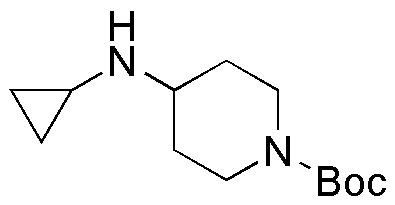1-Boc-4-cyclopropylaminopiperidine is widely utilized in research focused on:
- Pharmaceutical Development: This compound serves as a crucial intermediate in the synthesis of various pharmaceuticals, particularly those targeting neurological disorders, enhancing drug efficacy and specificity.
- Organic Synthesis: It is employed in organic chemistry for the construction of complex molecules, allowing researchers to explore new chemical pathways and develop innovative compounds.
- Biochemical Research: Used in studies involving receptor interactions, this chemical aids in understanding biological mechanisms, which can lead to the discovery of new therapeutic targets.
- Material Science: Its properties make it suitable for developing novel materials, particularly in creating polymers with specific functionalities, enhancing material performance in various applications.
- Agrochemical Formulations: The compound finds application in the development of agrochemicals, contributing to more effective pest control solutions while minimizing environmental impact.
Informations générales
Propriétés
Sécurité et réglementation
Applications
1-Boc-4-cyclopropylaminopiperidine is widely utilized in research focused on:
- Pharmaceutical Development: This compound serves as a crucial intermediate in the synthesis of various pharmaceuticals, particularly those targeting neurological disorders, enhancing drug efficacy and specificity.
- Organic Synthesis: It is employed in organic chemistry for the construction of complex molecules, allowing researchers to explore new chemical pathways and develop innovative compounds.
- Biochemical Research: Used in studies involving receptor interactions, this chemical aids in understanding biological mechanisms, which can lead to the discovery of new therapeutic targets.
- Material Science: Its properties make it suitable for developing novel materials, particularly in creating polymers with specific functionalities, enhancing material performance in various applications.
- Agrochemical Formulations: The compound finds application in the development of agrochemicals, contributing to more effective pest control solutions while minimizing environmental impact.
Documents
Fiches de données de sécurité (FDS)
La FDS fournit des informations de sécurité complètes sur la manipulation, le stockage et l’élimination du produit.
Spécifications du produit (PS)
Le PS fournit une description complète des propriétés du produit, notamment sa composition chimique, son état physique, sa pureté et les exigences de stockage. Il détaille également les plages de qualité acceptables et les applications prévues du produit.
Certificats d'analyse (COA)
Recherchez des certificats d'analyse (COA) en saisissant le numéro de lot du produit. Les numéros de lot et de lot se trouvent sur l'étiquette d'un produit, après les mots « Lot » ou « Lot de fabrication ».
Numéro de catalogue
Numéro de lot/série
Certificats d'origine (COO)
Ce certificat d'exploitation confirme le pays dans lequel le produit a été fabriqué, et détaille également les matériaux et composants utilisés et s'il est issu de sources naturelles, synthétiques ou autres sources spécifiques. Ce certificat peut être requis pour les douanes, le commerce et la conformité réglementaire.
Numéro de catalogue
Numéro de lot/série
Fiches de données de sécurité (FDS)
La FDS fournit des informations de sécurité complètes sur la manipulation, le stockage et l’élimination du produit.
DownloadSpécifications du produit (PS)
Le PS fournit une description complète des propriétés du produit, notamment sa composition chimique, son état physique, sa pureté et les exigences de stockage. Il détaille également les plages de qualité acceptables et les applications prévues du produit.
DownloadCertificats d'analyse (COA)
Recherchez des certificats d'analyse (COA) en saisissant le numéro de lot du produit. Les numéros de lot et de lot se trouvent sur l'étiquette d'un produit, après les mots « Lot » ou « Lot de fabrication ».
Numéro de catalogue
Numéro de lot/série
Certificats d'origine (COO)
Ce certificat d'exploitation confirme le pays dans lequel le produit a été fabriqué, et détaille également les matériaux et composants utilisés et s'il est issu de sources naturelles, synthétiques ou autres sources spécifiques. Ce certificat peut être requis pour les douanes, le commerce et la conformité réglementaire.


